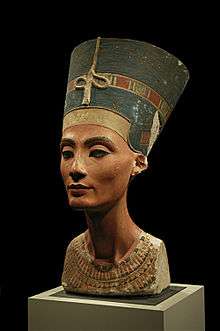History of cosmetics
The history of cosmetics spans at least 7,000 years and is present in almost every society on earth. Cosmetic body art is argued to have been the earliest form of a ritual in human culture. The evidence for this comes in the form of utilised red mineral pigments (red ochre) including crayons associated with the emergence of Homo sapiens in Africa.[1][2][3][4]
Archaeological evidence of cosmetics certainly dates from ancient Egypt and Greece. According to one source,[5] early major developments include the use of castor oil in ancient Egypt as a protective balm and skin creams made of beeswax, olive oil and rosewater described by the Romans. The Ancient Greeks also used cosmetics.[6][7] Cosmetics are mentioned in the Old Testament—2 Kings 9:30 where Jezebel painted her eyelids—approximately 840 BC—and the book of Esther describes various beauty treatments as well.
Cosmetics were also used in ancient Rome, although much of Roman literature suggests that it was frowned upon. It is known that some women in ancient Rome invented make up including lead-based formulas, to whiten the skin, and kohl was used to line the eyes.[8]
Across the globe
Egypt
The use of cosmetics in Ancient Egypt is well documented. Kohl has its roots in north Africa. Remedies to treat wrinkles containing ingredients such as gum of frankincense and fresh moringa. For scars and burns, a special ointment was made of red ochre, kohl, and sycamore juice. An alternative treatment was a poultice of carob grounds and honey, or an ointment made of knotgrass and powdered root of wormwood. To improve breath the ancient Africans chewed herbs or frankincense which is still in use today. Jars of what could be compared with setting lotion have been found to contain a mixture of beeswax and resin. These doubled as remedies for problems such as baldness and greying hair. They also used these products on their mummies, because they believed that it would make them irresistible in the after life.
Middle East
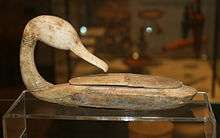
Cosmetics were used in Persia and what today is Iran from ancient periods. Kohl is a black powder that is used widely across the Persian Empire. It is used as a powder or smeared to darken the edges of the eyelids similar to eyeliner.[9] After Persian tribes converted to Islam and conquered those areas, in some areas cosmetics were only restricted if they were to disguise the real look in order to mislead or cause uncontrolled desire. In Islamic law, despite these requirements, there is no absolute prohibition on wearing cosmetics; the cosmetics must not be made of substances that harm one's body.
An early teacher in the 10th century was Abu al-Qasim al-Zahrawi, or Abulcasis, who wrote the 24-volume medical encyclopedia Al-Tasrif. A chapter of the 19th volume was dedicated to cosmetics. As the treatise was translated into Latin, the cosmetic chapter was used in the West. Al-Zahrawi considered cosmetics a branch of medicine, which he called "Medicine of Beauty" (Adwiyat al-Zinah). He deals with perfumes, scented aromatics and incense. There were perfumed sticks rolled and pressed in special molds, perhaps the earliest antecedents of present-day lipsticks and solid deodorants. He also used oily substances called Adhan for medication and beautification.
China
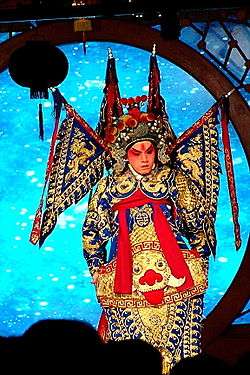
Chinese people began to stain their fingernails with gum arabic, gelatin, beeswax and egg white from around 3000 BC. The colors used represented social class: Chou dynasty (first millennium BC) royals wore gold and silver; later royals wore black or red. The lower classes were forbidden to wear bright colors on their nails.[10]
Flowers play an important decorative role in China. Legend has it that once on the 7th day of the 1st lunar month, while Princess Shouyang (壽陽公主), daughter of Emperor Wu of Liu Song (劉宋武帝), was resting under the eaves of Hanzhang Palace near the plum trees after wandering in the gardens, a plum blossom drifted down onto her fair face, leaving a floral imprint on her forehead that enhanced her beauty further.[11][12][13] The court ladies were said to be so impressed, that they started decorating their own foreheads with a small delicate plum blossom design.[11][12][14] This is also the mythical origin of the floral fashion, meihua zhuang[12] (梅花妝; literally "plum blossom makeup"), that originated in the Southern Dynasties (420–589) and became popular amongst ladies in the Tang (618–907) and Song (960–1279) dynasties.[14][15]
Mongolia
Women of royal families painted red spots on the center of their cheeks, right under their eyes. However, it is a mystery why.
Japan
In Japan, geisha wore lipstick made of crushed safflower petals to paint the eyebrows and edges of the eyes as well as the lips, and sticks of bintsuke wax, a softer version of the sumo wrestlers' hair wax, were used by geisha as a makeup base. Rice powder colors the face and back; rouge contours the eye socket and defines the nose.[16] Ohaguro (black paint) colours the teeth for the ceremony, called Erikae, when maiko (apprentice geisha) graduate and become independent.The geisha would also sometimes use bird droppings to compile a lighter color.
Europe
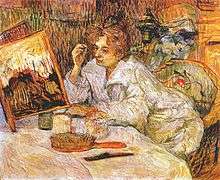
In the Roman Empire, the use of cosmetics was common amongst prostitutes and rich women. Such adornment was sometimes lamented by certain Roman writers, who thought it to be against the castitas required of women by what they considered traditional Roman values; and later by Christian writers who expressed similar sentiments in a slightly different context. Pliny the Elder mentioned cosmetics in his Naturalis Historia, and Ovid wrote a book on the topic.
In the Middle Ages it was thought sinful and immoral to wear makeup by Church leaders, but many women still did so. From the Renaissance up until the 20th century the lower classes had to work outside, in agricultural jobs and the typically light-colored European's skin was darkened by exposure to the sun. The higher a person was in status, the more leisure time he or she had to spend indoors, which kept their skin pale. Thus, the highest class of European society were pale resulting in European men and women attempting to lighten their skin directly, or using white powder on their skin to look more aristocratic. A variety of products were used, including white lead paint which also may have contained arsenic, which also poisoned and killed many. Queen Elizabeth I of England was one well-known user of white lead, with which she created a look known as "the Mask of Youth".[17] Portraits of the queen by Nicholas Hilliard from later in her reign are illustrative of her influential style.
Pale faces were a trend during the European Middle Ages. In the 16th century, women would bleed themselves to achieve pale skin. Spanish prostitutes wore pink makeup to contract pale skin. 13th century Italian women wore red lipstick to show that they were upperclass.[18]..
The Americas and Australia
Some Native American tribes painted their faces for ceremonial events or battle. Similar practices were followed by Aboriginals in Australia.
Recent history
20th century
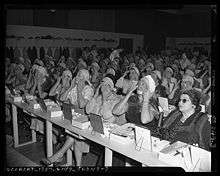
During the early 1900s, makeup was not excessively popular. In fact, women hardly wore makeup at all. Make-up at this time was still mostly the territory of prostitutes, those in cabarets and on the black & white screen.[19] Face enamelling (applying actual paint to the face) became popular among the rich at this time in an attempt to look paler. This practice was dangerous due to the main ingredient often being arsenic.[20] Pale skin was associated with wealth because it meant that one was not out working in the sun and could afford to stay inside all day. Cosmetics were so unpopular that they could not be bought in department stores; they could only be bought at theatrical costume stores. A woman's "makeup routine" often only consisted of using papier poudré, a powdered paper/oil blotting sheet, to whiten the nose in the winter and shine their cheeks in the summer. Rouge was considered provocative, so was only seen on "women of the night." Some women used burnt matchsticks to darken eyelashes, and geranium and poppy petals to stain the lips.[20] Vaseline became high in demand because it was used on chapped lips, as a base for hair tonic, and soap.[20] Toilet waters were introduced in the early 1900s, but only lavender water or refined cologne was admissible for women to wear.[21] Cosmetic deodorant was invented in 1888, by an unknown inventor from Philadelphia and was trademarked under the name Mum (deodorant). Roll-on deodorant was launched in 1952, and aerosol deodorant in 1965.
Around 1910, make-up became fashionable in the United States of America and Europe owing to the influence of ballet and theatre stars such as Mathilde Kschessinska and Sarah Bernhardt. Colored makeup was introduced in Paris upon the arrival of the Russian Ballet in 1910, where ochers and crimsons were the most typical shades.[22] The Daily Mirror beauty book showed that cosmetics were now acceptable for the literate classes to wear. With that said, men often saw rouge as a mark of sex and sin, and rouging was considered an admission of ugliness. In 1915, a Kansas legislature proposed to make it a misdemeanor for women under the age of forty-four to wear cosmetics "for the purpose of creating a false impression."[23] The Daily Mirror was one of the first to suggest using a pencil line (eyeliner) to elongate the eye and an eyelash curler to accentuate the lashes. Eyebrow darkener was also presented in this beauty book, created from gum Arabic, Indian ink, and rosewater.[24] George Burchett developed cosmetic tattooing during this time period. He was able to tattoo on pink blushes, red lips, and dark eyebrows. He also was able to tattoo men disfigured in the First World War by inserting skin tones in damaged faces and by covering scars with colors more pleasing to the eye.[25] Max Factor opened up a professional makeup studio for stage and screen actors in Los Angeles in 1909.[26] Even though his store was intended for actors, ordinary women came in to purchase theatrical eye shadow and eyebrow pencils for their home use.
In the 1920s, the film industry in Hollywood had the most influential impact on cosmetics. Stars such as Theda Bara had a substantial effect on the makeup industry. Helena Rubinstein was Bara's makeup artist; she created mascara for the actress, relying on her experiments with kohl.[27] Others who saw the opportunity for the mass-market of cosmetics during this time were Max Factor, Sr., and Elizabeth Arden. Many of the present day makeup manufacturers were established during the 1920s and 1930s. Lipsticks were one of the most popular cosmetics of this time, more so than rouge and powder, because they were colorful and cheap. In 1915, Maurice Levy invented the metal container for lipstick, which gave license to its mass production.[28] The Flapper style also influenced the cosmetics of the 1920s, which embraced dark eyes, red lipstick, red nail polish, and the suntan, invented as a fashion statement by Coco Chanel. The eyebrow pencil became vastly popular in the 1920s, in part because it was technologically superior to what it had been, due to a new ingredient: hydrogenated cottonseed oil (also the key constituent of another wonder product of that era Crisco Oil).[29] The early commercial mascaras, like Maybelline, were simply pressed cakes containing soap and pigments. A woman would dip a tiny brush into hot water, rub the bristles on the cake, remove the excess by rolling the brush onto some blotting paper or a sponge, and then apply the mascara as if her eyelashes were a watercolor canvas.[29] Eugene Schueller, founder of L'Oréal, invented modern synthetic hair dye in 1907 and he also invented sunscreen in 1936.[30] The first patent for a nail polish was granted in 1919. Its color was a very faint pink. It's not clear how dark this rose was, but any girl whose nails were tipped in any pink darker than a baby's blush risked gossip about being "fast."[29] Previously, agricultural workers had only sported suntans, while fashionable women kept their skins as pale as possible. In the wake of Chanel's adoption of the suntan, dozens of new fake tan products were produced to help both men and women achieve the "sun-kissed" look. In Asia, skin whitening continued to represent the ideal of beauty, as it does to this day.
In the time period after the First World War, there was a boom in cosmetic surgery. During the 1920s and 1930s, facial configuration and social identity dominated a plastic surgeon's world. Face-lifts were performed as early as 1920, but it wasn't until the 1960s when cosmetic surgery was used to reduce the signs of aging.[31] During the twentieth century, cosmetic surgery mainly revolved around women. Men only participated in the practice if they had been disfigured by the war. Silicone implants were introduced in 1962. In the 1980s, the American Society of Plastic Surgeons made efforts to increase public awareness about plastic surgery. As a result, in 1982, the United States Supreme Court granted physicians the legal right to advertise their procedures.[32] The optimistic and simplified nature of narrative advertisements often made the surgeries seem hazard-free, even though they were anything but. The American Society for Aesthetic Plastic Surgery reported that more than two million Americans elected to undergo cosmetic procedures, both surgical and non-surgical, in 1998, liposuction being the most popular. Breast augmentations ranked second, while numbers three, four, and five went to eye surgery, face-lifts, and chemical peels.[31]
During the 1920s, numerous African Americans participated in skin bleaching in an attempt to lighten their complexion as well as hair straightening to appear whiter. Skin bleaches and hair straighteners created fortunes worth millions and accounted for a massive thirty to fifty percent of all advertisements in the black press of the decade.[33] Oftentimes, these bleaches and straighteners were created and marketed by African American women themselves. Skin bleaches contained caustic chemicals such as hydroquinone, which suppressed the production of melanin in the skin. These bleaches could cause severe dermatitis and even death in high dosages. Many times these regimens were used daily, increasing an individual's risk. In the 1970s, at least 5 companies started producing make-up for African American women. Before the 1970s, makeup shades for Black women were limited. Face makeup and lipstick did not work for dark skin types because they were created for pale skin tones. These cosmetics that were created for pale skin tones only made dark skin appear grey. Eventually, makeup companies created makeup that worked for richer skin tones, such as foundations and powders that provided a natural match. Popular companies like Astarté, Afram, Libra, Flori Roberts and Fashion Fair priced the cosmetics reasonably due to the fact that they wanted to reach out to the masses.[34]
From 1939 to 1945, during the Second World War, cosmetics were in short supply.[35] Petroleum and alcohol, basic ingredients of many cosmetics, were diverted into war supply. Ironically, at this time when they were restricted, lipstick, powder, and face cream were most desirable and most experimentation was carried out for the post war period. Cosmetic developers realized that the war would result in a phenomenal boom afterwards, so they began preparing. Yardley, Elizabeth Arden, Helena Rubinstein, and the French manufacturing company became associated with "quality" after the war because they were the oldest established. Pond's had this same appeal in the lower price range. Gala cosmetics were one of the first to give its products fantasy names, such as the lipsticks in "lantern red" and "sea coral."[36]
During the 1960s and 1970s, many women in the western world influenced by feminism decided to go without any cosmetics. In 1968 at the feminist Miss America protest, protestors symbolically threw a number of feminine products into a "Freedom Trash Can." This included cosmetics,[37] which were among items the protestors called "instruments of female torture"[38] and accouterments of what they perceived to be enforced femininity.
Cosmetics in the 1970s were divided into a "natural look" for day and a more sexualized image for evening. Non-allergic makeup appeared when the bare face was in fashion as women became more interested in the chemical value of their makeup.[39] Modern developments in technology, such as the High-shear mixer facilitated the production of cosmetics which were more natural looking and had greater staying power in wear than their predecessors.[40] The prime cosmetic of the time was eye shadow, though; women also were interested in new lipstick colors such as lilac, green, and silver.[41] These lipsticks were often mixed with pale pinks and whites, so women could create their own individual shades. "Blush-ons" came into the market in this decade, with Revlon giving them wide publicity.[41] This product was applied to the forehead, lower cheeks, and chin. Contouring and highlighting the face with white eye shadow cream also became popular. Avon introduced the lady saleswoman.[42] In fact, the whole cosmetic industry in general opened opportunities for women in business as entrepreneurs, inventors, manufacturers, distributors, and promoters.[43]
21st century
Beauty products are now widely available from dedicated internet-only retailers,[44] who have more recently been joined online by established outlets, including the major department stores and traditional bricks and mortar beauty retailers.
Like most industries, cosmetic companies resist regulation by government agencies. In the U.S., the Food and Drug Administration (FDA) does not approve or review cosmetics, although it does regulate the colors that can be used in the hair dyes. The cosmetic companies are not required to report injuries resulting from use of their products.[45]
Although modern makeup has been used mainly by women traditionally, gradually an increasing number of males are using cosmetics usually associated to women to enhance their own facial features. Concealer is commonly used by cosmetic-conscious men. Cosmetics brands are releasing cosmetic products especially tailored for men, and men are using such products more commonly.[46] There is some controversy over this, however, as many feel that men who wear make-up are neglecting traditional gender, and do not view men wearing cosmetics in a positive light. Others, however, view this as a sign of ongoing gender equality and feel that men also have rights to enhance their facial features with cosmetics if women could.
Today the market of cosmetics has a different dynamic compared to the 20th century. Some countries are driving this economy:
- Japan:
Japan is the second largest market in the world. Regarding the growth of this market, cosmetics in Japan have entered a period of stability. However, the market situation is quickly changing. Now consumers can access a lot of information on the Internet and choose many alternatives, opening up many opportunities for newcomers entering the market, looking for chances to meet the diverse needs of consumers. The size of the cosmetics market for 2010 was 2286 billion yen on the basis of the value of shipments by brand manufacturer. With a growth rate of 0.1%, the market was almost unchanged from the previous year.[47]
- Russia:
One of the most interesting emerging markets, the 5th largest in the world in 2012, the Russian perfumery and cosmetics market has shown the highest growth of 21% since 2004, reaching US$13.5 billion.
References
- Power, C. 2010. Cosmetics, identity and consciousness. Journal of Consciousness Studies 17, 7-8: 73-94.
- Power, C. 2004. Women in prehistoric art. In G. Berghaus (ed.), New Perspectives in Prehistoric Art. Westport, CT & London: Praeger, pp. 75-104.
- Watts, Ian. 2009. Red ochre, body painting and language: in-terpreting the Blombos ochre. In The Cradle of Language, Rudolf Botha and Chris Knight (eds.), pp. 62–92. Oxford: Oxford University Press.
- Watts, Ian. 2010. The pigments from Pinnacle Point Cave 13B, Western Cape, South Africa. Journal of Human Evolution 59: 392–411.
- Günther Schneider, Sven Gohla, Jörg Schreiber, Waltraud Kaden, Uwe Schönrock, Hartmut Schmidt-Lewerkühne, Annegret Kuschel, Xenia Petsitis, Wolfgang Pape, Hellmut Ippen and Walter Diembeck "Skin Cosmetics" in Ullmann's Encyclopedia with help of Industrial Chemistry 2005, Wiley-VCH, Weinheim. doi:10.1002/14356007.a24_219
- Lesley Adkins, Roy A. Adkins, Handbook to life in Ancient Greece, Oxford University Press, 1998
- Bruno Burlando, Luisella Verotta, Laura Cornara, and Elisa Bottini-Massa, Herbal Principles in Cosmetics, CRC Press, 2010
- Olson, Kelly. "Cosmetics in Roman Antiquity: Substance, Remedy, Poison." The Classical World Vol. 102, No. 3 (SPRING 2009), pp. 294-298. The Johns Hopkins University Press.
- Oumeish, OY. "The Cultural and Philosophical Concepts of Cosmetics in Beauty and Art Through the Medical History of Mankind." Clinics in Dermatology. 19.4 (2001). Print.
- "A History of Nail Lacquer: Blood Red Nails On Your Fingertips". www.beautifully-invisible.com.
- Cai, Zong-qi, ed. (2008). How to read Chinese poetry: A guided anthology. New York: Columbia University Press. p. 295. ISBN 978-0-231-13941-0.
- Wang, Betty. "Flower deities mark the lunar months with stories of Love & Tragedy". Taiwan Review. Government Information Office, Republic of China. Archived from the original on 25 May 2012. Retrieved 20 November 2011.
- West & East 中美月刊. Sino-American Cultural and Economic Association. 36-37: 9. 1991. ISSN 0043-3047 https://books.google.com/books?ei=qXyQTqOYOIqVOpbimcwN. Missing or empty
|title=(help) - Huo, Jianying. "Ancient Cosmetology". China Today. Retrieved 8 October 2011.
- Mei, Hua (2011). Chinese clothing. Cambridge: Cambridge University Press. p. 32. ISBN 978-0-521-18689-6.
For example, the Huadian or forehead decoration was said to have originated in the South Dynasty, when the Shouyang Princess was taking a walk in the palace in early spring and a light breeze brought a plum blossom onto her forehead. The plum blossom for some reason could not be washed off or removed in any way. Fortunately, it looked beautiful on her, and all of a sudden became all the rage among the girls of the commoners. It is therefore called the "Shouyang makeup" or the "plum blossom makeup." This makeup was popular among the women for a long time in the Tang and Song Dynasties.
- Make-Up of Geisha and Maiko Archived 9 February 2010 at the Wayback Machine. Immortal Geisha. Retrieved on 29 September 2010.
- History of Cosmetics. Health-and-beauty-advice.com. Retrieved on 29 September 2010.
- inFlux '99 | A Colorful History. Influx.uoregon.edu. Retrieved on 29 September 2010.
- Sava, Sanda (5 May 2016). "A history of Make-up & Fashion: 1900-1910". sandasava.com. Retrieved 19 May 2016.
- Maggie Angelogou. A history of makeup. (London: Studio vista Ltd, 1970), 113.
- Maggie Angelogou. A history of makeup. (London: Studio vista Ltd, 1970), 114.
- Maggie Angelogou. A history of makeup. (London: Studio vista Ltd, 1970), 115.
- Kathy Peiss. Hope In a Jar. (New York: Metropolitan Books, 1998), 55.
- Maggie Angelogou. A history of makeup. (London: Studio vista Ltd, 1970), 116.
- Maggie Angelogou. A history of makeup. (London: Studio vista Ltd, 1970), 117.
- Kathy Peiss. Hope In a Jar. (New York: Metropolitan Books, 1998), 58.
- Maggie Angelogou. A history of makeup. (London: Studio vista Ltd, 1970), 119.
- Maggie Angelogou. A history of makeup. (London: Studio vista Ltd, 1970), 125.
- Teresa Riordan. Inventing Beauty. (New York: Broadway Books, 2004).
- L'Oréal. Loreal.com (8 December 2009). (accessed on 29 September 2010).
- Elizabeth Haiken. "The Making of the Modern Face: Cosmetic Surgery." Social Research 67, no. 1 (March 2000): 81-97. Academic Search Complete, EBSCOhost (accessed March 29, 2015).
- Lee Shu-Yueh and Naeemah Clark. "The Normalization of Cosmetic Surgery in Women's Magazines from 1960 to 1989." Journal of Magazine & New Media Research 15, no. 1 (April 2014): 1-22. Communication & Mass Media Complete, EBSCOhost (accessed March 29, 2015).
- Jacob S. Dorman. "Skin Bleach And Civilization: The Racial Formation of Blackness in 1920s Harlem." Journal of Pan African Studies 4, no. 4 (June 2011): 47-80. Academic Search Complete, EBSCOhost (accessed March 29, 2015).
- "Modern Living: Black Cosmetics". Time Magazine. 29 June 1970. (accessed 9 February 2010).
- Maggie Angelogou. A history of makeup. (London: Studio vista Ltd, 1970), 127.
- Maggie Angelogou. A history of makeup. (London: Studio vista Ltd, 1970), 131
- Dow, Bonnie J. (Spring 2003). "Feminism, Miss America, and Media Mythology". Rhetoric & Public Affairs. 6 (1): 127–149. doi:10.1353/rap.2003.0028.
- Duffett, Judith (October 1968). WLM vs. Miss America. Voice of the Women's Liberation Movement. p. 4.
- Maggie Angelogou. A history of makeup. (London: Studio vista Ltd, 1970), 138
- "Cosmetics and Personal Care Products Naobay". Charles Ross & Son Company. (accessed 7 June 2009).
- Maggie Angelogou. A history of makeup. (London: Studio vista Ltd, 1970), 135.
- Maggie Angelogou. A history of makeup. (London: Studio vista Ltd, 1970), 137.
- Kathy Peiss. Hope In a Jar. (New York: Metropolitan Books, 1998), 5.
- "Lessons from categorising the entire beauty products sector (Part 1)". p. 1. Retrieved 28 September 2009.
- "Cosmetics and your health." womensheatlh.gov.nd.web.4 nov 2004
- "Archived copy". Archived from the original on 13 May 2009. Retrieved 23 October 2011.CS1 maint: archived copy as title (link)
- ""The Japanese cosmetics market is actively changing," Hajime Suzuki, Cosme Tokyo".
External links
- Early 19th Century Cosmetics in England during the British Regency
- Naked face project: Women try no-makeup experiment - USATODAY.com (28 March 2012)
